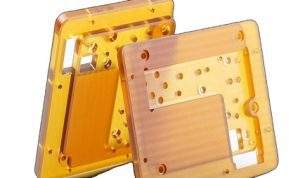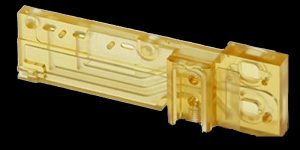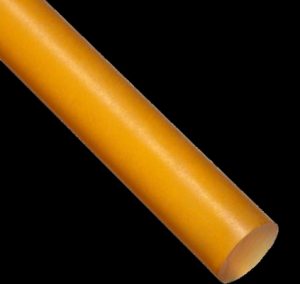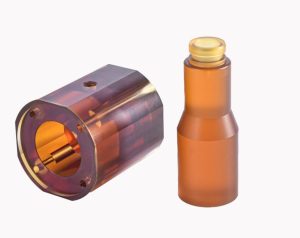- What is Ultem (PEI)?
- How Do Ultem’s Material Properties Influence CNC Machining Processes?
- What are the Various Grades of Machined ULTEM?
- What Industries Benefit Most from Ultem Machined Parts, and Why?
- How do you optimize your design for machining with Ultem?
- What are the Differences between PEEK vs. Ultem Machining?
- What Finishing Options Are Available for Ultem Machined Parts?
- Conclusion
Machining Ultem(PEI): Everything You Need to Know
When machining high-performance plastics, the conversation often turns to Ultem (PEI) – a material known for its impressive blend of thermal, chemical, and mechanical properties. As a professional deeply entrenched in CNC machining, I’ve had my fair share of experiences with Ultem. From the initial design considerations to the final product, the journey of machining Ultem is filled with unique challenges and opportunities.
Its thermoplastic combines high strength, exceptional thermal stability, and excellent chemical resistance, making it a preferred choice for many high-demand applications.
Stay tuned because this journey through the world of Ultem machining is about to get interesting.
What is Ultem (PEI)?

Ultem® (PEI) is a semi-transparent thermoplastic with outstanding mechanical, thermal, and chemical properties. It is an amorphous material, which means it has a high glass transition temperature of 217°C. This characteristic alone propels Ultem into the upper echelons of engineering plastics, capable of maintaining its integrity in environments that would compromise lesser materials.
Manufactured by SABIC, Ultem’s pedigree is as impressive as its performance. It offers a rare combination of high strength and rigidity at elevated temperatures, excellent electrical properties, and inherent flame resistance without requiring additives. Furthermore, Ultem is resistant to repeated sterilization cycles, making it an ideal choice for medical and pharmaceutical applications.
One of Ultem’s most lauded features is its ability to perform under extreme conditions. Whether exposed to high temperatures, aggressive chemicals, or constant wear and tear, Ultem stands its ground, ensuring reliability and longevity. This resilience makes it a favored material for aerospace, automotive, electrical/electronic, and medical industries.
Moreover, Ultem’s ease of machining allows for creating complex parts with tight tolerances. Its compatibility with CNC machining processes means that designers and engineers can push the boundaries of innovation, crafting components that meet precise specifications while offering superior performance.
How Do Ultem’s Material Properties Influence CNC Machining Processes?
First and foremost, Ultem’s high strength and rigidity, even at elevated temperatures, can withstand machining without deforming. This characteristic is a double-edged sword; while it allows for creating parts with tight tolerances and fine details, it also requires sharp tools and precise machining parameters to avoid excessive stress on the material and the cutting tools.
The thermal stability of Ultem is another critical factor. Its high glass transition temperature allows it to maintain its structural integrity at temperatures where other plastics might warp or degrade. However, this also means careful consideration must be given to heat management during machining. Excessive heat can lead to material softening and, subsequently, dimensional inaccuracies. Techniques such as peck drilling, intermittent cutting, and using coolant can help manage the heat generated during machining.
Chemical resistance is a hallmark of Ultem, allowing it to be used without deteriorating in environments exposed to harsh chemicals. This resistance, however, also means that not all coolants or cutting fluids are suitable for use with Ultem. Selecting the proper coolant that won’t react with or degrade the material is crucial to ensure the longevity of the machined parts and the tools.
Ultem’s amorphous nature contributes to its excellent machinability, allowing for smoother cuts and a quality finish. Yet, this same property requires adjustments in machining tactics. For instance, slower feed rates and higher spindle speeds might be necessary to achieve the desired surface quality without causing stress to the material.
Furthermore, Ultem’s inherent flame resistance and low smoke generation during machining make it safer, especially in industries where fire safety is paramount.
Nevertheless, this does not eliminate the need for vigilant machining process monitoring to prevent any potential hazards.
What are the Various Grades of Machined ULTEM?
Ultem 1000 Series
The Ultem 1000 series represents the base grade, offering the standard balance of heat resistance, mechanical strength, and chemical resistance that Ultem is known for. It is inherently flame-resistant and possesses excellent electrical insulation properties.
This grade is often chosen for its general-purpose qualities, serving as a reliable choice when the enhanced features of other grades are not a necessity.
Ultem 2300 Series
The 2300 series is a glass-reinforced grade of Ultem, designed to offer higher stiffness, improved dimensional stability, and greater strength than the unfilled 1000 series. Adding glass fibers enhances its mechanical properties, making it an excellent choice for applications requiring robustness and durability under load.
However, the glass reinforcement also makes this grade more abrasive to machining tools, requiring specialized tooling or adjustments in machining parameters.
Ultem 2100 and 2200 Series
These grades are carbon fiber-reinforced, providing an exceptional strength-to-weight ratio, thermal conductivity, and lower expansion rates. The carbon fibers contribute to the material’s strength and improve its thermal management capabilities, making these grades ideal for applications where heat dissipation is critical.
Machining these grades demands attention to detail, as the carbon fibers can affect surface finish and tool wear.
Ultem PEI+PBI Blend
This blend combines Ultem with polybenzimidazole (PBI), further pushing the boundaries of temperature resistance and mechanical performance. This grade is designed for the most extreme applications, where thermal stability up to 430°C and beyond is required.
The blend offers the highest heat resistance, exceptional strength, and flame retardancy among Ultem grades. Machining this material requires specialized knowledge and equipment due to its excellent properties.
What Industries Benefit Most from Ultem Machined Parts, and Why?
- Aerospace
- Medical and Pharmaceutical
- Electrical/Electronic
- Automotive
- Food Processing
- Semiconductor
How do you optimize your design for machining with Ultem?
Understand Ultem’s Material Properties
First and foremost, familiarize yourself with Ultem’s unique characteristics, such as its thermal stability, mechanical strength, and chemical resistance. Knowing these properties allows you to design parts that leverage Ultem’s strengths while avoiding conditions that could lead to failure.
Minimize Internal Stresses
Ultem’s performance is significantly influenced by internal stresses, which can be introduced during machining. Design your parts to minimize these stresses by avoiding sharp inner corners, which can concentrate stress. Use radii instead of sharp angles whenever possible, and consider the part’s orientation during machining to reduce stress concentrations.
Consider Heat Management
Given Ultem’s high glass transition temperature, managing heat during machining is crucial. Design parts with features that allow for efficient heat dissipation. This may include designing thin walls cautiously and incorporating features that facilitate coolant flow around the part during machining.
Optimize Wall Thickness
Achieving the right balance in wall thickness is vital. Too thin, and the parts may be too fragile or warp during machining; too thick, and you risk internal stresses and uneven cooling. A uniform wall thickness is generally recommended to ensure even cooling and minimize warping or distortion.
Simplify Complex Geometries
While Ultem can be machined into complex geometries, simplifying these designs can significantly reduce machining time and costs. Consider which features are essential for functionality and which can be simplified or removed without compromising performance.
Leverage the Advantages of CNC Machining
Take full advantage of CNC machining’s precision and capabilities by designing optimized parts for this process. This includes considering the tool’s path and ensuring sufficient clearance for tooling to avoid collisions and provide a high-quality surface finish.
Plan for Finishing Processes
Suppose your Ultem part requires post-machining finishing processes, such as polishing or painting; design with these steps in mind. Ensure that surfaces intended for finishing are accessible and that the design does not include features that could complicate these processes.
Collaborate with Machining Experts
The most crucial strategy is to engage with CNC machining experts early in the design process. Their experience with Ultem can provide valuable insights into how to optimize your design for machining, suggesting adjustments that improve manufacturability and performance.
What are the Differences between PEEK vs. Ultem Machining?

Thermal Properties
PEEK is renowned for its high heat resistance, with a continuous service temperature of up to 260°C, compared to Ultem, which has a continuous service temperature of around 180°C.
This higher thermal resistance of PEEK impacts its machinability, often requiring more careful management of cutting temperatures to prevent material degradation or distortion during machining.
Mechanical Strength
Both materials are strong, but PEEK generally offers higher tensile strength than Ultem. This difference means that PEEK can be more challenging to machine, as it may require more force to cut, leading to potential tool wear. While also robust, Ultem allows for somewhat easier machining under similar conditions due to its slightly lower strength than PEEK.
Chemical Resistance
PEEK exhibits superior chemical resistance, especially to hydrolysis, even at high temperatures. This resistance can affect the choice of coolants or lubricants during machining, as some fluids may interact with materials.
Ultem also offers excellent chemical resistance, but the superior performance of PEEK in aggressive chemical environments may necessitate different machining considerations to avoid contamination or damage.
Machining Parameters
Due to their different thermal and mechanical properties, PEEK and Ultem require distinct machining parameters. PEEK’s higher strength and thermal resistance typically demand slower feed rates and higher cutting speeds to minimize heat buildup and ensure smooth cuts.
In contrast, Ultem can be machined with slightly more aggressive feed rates due to its lower thermal resistance, allowing for faster removal rates without compromising part integrity.
Tool Wear

Machining PEEK, especially reinforced grades, can lead to increased tool wear due to its abrasive nature. Tools used for machining PEEK may require more frequent replacement or reconditioning.
While still challenging, Ultem tends to be less abrasive on tools, potentially reducing tool costs over time.
Surface Finish
Both materials can achieve excellent surface finishes with proper machining practices. However, the specific machining strategies and tool paths might differ due to the materials’ responses to machining processes. Achieving the best possible finish may require adjustments in tooling, speeds, and feeds specific to each material.
Cost Considerations
Finally, the cost of machining these materials can differ significantly. PEEK’s higher price point and potentially increased tool wear contribute to higher overall machining costs than Ultem. This cost difference should be considered when selecting materials for a project, especially for large-scale or high-volume manufacturing.
What Finishing Options Are Available for Ultem Machined Parts?
Polishing
Polishing is a common finishing technique for Ultem parts to achieve a smooth, reflective surface. This process can be manual or automated, using abrasives to refine the surface gradually.
Polishing not only improves the appearance of Ultem parts but can also contribute to their cleanliness and reduce the adhesion of contaminants, which is particularly beneficial in medical and food processing applications.
Painting and Coating
Applying paints or coatings to Ultem parts can provide additional protection against environmental factors, enhance chemical resistance, or add color for aesthetic or identification purposes.
When selecting paints or coatings, choosing formulations compatible with Ultem’s chemical composition is essential to ensure strong adhesion and durability. Specialized coatings can also impart additional properties, such as increased wear resistance or reduced friction.
Chemical Resistance Enhancement
While Ultem inherently possesses excellent chemical resistance, certain applications may require enhanced performance. Chemical resistance treatments or coatings can further improve Ultem’s ability to withstand aggressive substances, making it even more suitable for
chemical processing equipment or components exposed to harsh cleaning agents.
Stabilization
A UV stabilizing finish can be applied to applications where Ultem parts are exposed to UV radiation to prevent degradation or discoloration over time. This treatment is essential for outdoor applications or any environment where UV exposure is significant, ensuring that the parts maintain their mechanical properties and appearance.
Marking
Laser marking offers a precise and durable method for directly adding identification marks, logos, or instructions onto Ultem parts. This technique is highly beneficial for medical devices, aerospace components, and other applications where clear, permanent marking is necessary for traceability, compliance, or operational guidance.
Thermal Bonding and Welding
Ultem parts can be finished through thermal bonding or welding to create complex assemblies or join components with a robust and seamless bond. These techniques require careful control of temperature and pressure to ensure a successful bond without compromising the integrity of the material.
Vapor Polishing
Vapor polishing is a specialized finishing technique that uses a chemical vapor to slightly melt the surface of Ultem parts, resulting in a glass-like finish. This process is beneficial for improving the transparency of Ultem components or achieving an ultra-smooth surface for optical applications.
Conclusion
Whether you’re at the concept stage or ready for production, embracing Ultem’s potential can elevate your projects to new heights. If you’re looking to harness the power of Ultem for your next challenge, we invite you to reach out and explore how our expertise can bring your vision to life.




